(請注意:中文版本並未隨英文版本同步更新!)
Slides: DTW, DTW for melody recognition, DTW for speech recognition
一般而言,對於兩個 n 維空間中的向量 x 和 y,它們之間的距離可以定義為兩點之間的直線距離,稱為歐基里得距離(Euclidean Distance): $$ dist(\mathbf{x},\mathbf{y})=\|\mathbf{x}-\mathbf{y}\|=\sqrt{(x_1-y_1)^2+(x_2-y_2)^2+\cdots+(x_n-y_n)^2}. $$
但是如果向量的長度不同,那它們之間的距離,就無法使用上述的數學式來計算。一般而言,假設這兩個向量的元素位置都是代表時間,由於我們必須容忍在時間軸的偏差,因此我們並不知道兩個向量的元素對應關係,因此我們必須靠著一套有效的運算方法,才可以找到最佳的對應關係。
DTW 是 Dynamic Time Warping 的簡稱,中文可以翻譯成「動態時間扭曲」或是「動態時間校正」,這是一套根基於「動態規劃」(Dynamic Programming,簡稱 DP)的方法,可以有效地將搜尋比對的時間大幅降低。
假設有兩個向量 t 和 r,長度分別是 m 和 n,那麼 DTW 的目標,就是要找到一組路徑 (p1, q1), (p2, q2), ..., (pk, qk)}, 使得經由上述路徑的「點對點」對應距離和 Si=1k ∣t(pi) - r(qi)∣ 為最小,而且,此路徑必須滿足下列條件:
- 端點關係:(p1, q1) = (1, 1), (pk, qk) = (m, n)。此端點關係代表這是「頭對頭、尾對尾」的比對。
- 局部關係:假設最佳路徑上任一點可以表示成 (i, j),那麼其前一點路徑只有三種可能:(i-1, j), (i, j-1), (i-1, j-1)。此局部關係定義了路徑的連續性,而且也規定了 t 的任一個元素至少對應一個 r 的元素,反之亦然。
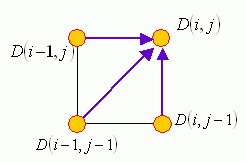
但是,我們要如何很快地找到這條最佳路徑呢?我們可以根據 DP 的原理,來將 DTW 描述成下列三個步驟:
- 目標函數之定義:定義 D(i, j) 是 t(1:i) 和 r(1:j) 之間的 DTW 距離,對應的最佳路徑是由 (1, 1) 走到 (i, j)。
- 目標函數之遞迴關係:D(i, j) = ∣t(i) - r(j)∣ + min{D(i-1, j), D(i-1, j-1), D(i, j-1)},其端點條件為 D(1, 1) = ∣t(1) - r(1)∣
- 最後答案:$D(m, n)$.
在上述的方法描述中,我們是有點濫用數學符號,嚴格地說,D(i, j) 應該表示成為 D(t(1:i), r(1:j)),才能準確地描述 D(•,•) 和 t、r 的關係。另外,D() 具有下列對稱的性質:D(t(1:i), r(1:j)) = D(r(1:j), t(1:i))。
在實際運算時,我們通常事先建立一個矩陣 D,其維度為 m×n,先根據端點條件來填入 D(1, 1),然後再根據遞迴關係,逐行或逐列算出 D(i, j) 的值,最後就可以得到我們所要的答案 D(m, n)。有上述方法可得知,DTW 的計算複雜度大約是 O(mn),比用暴力法是有效率多了。
如果我們除了要知道 DTW 距離之外,也希望把相關最佳路徑找出來,此時在計算遞迴關係式時,就要記錄每一個最小點所對應的路徑,直到我們求出 D(m, n),在反覆回推前一個最佳路徑的位置,如此一再反覆,才能算出整個最佳路徑,這個步驟在 DP 裡面稱為 Back Tracking。
此外,在上述方法中,我們定義的子路徑是由 (1, 1) 走到 (i, j),我們也可以反向操作,定義子路徑是由 (i, j) 走到 (m, n),此時對應的 DTW 解法可以描述成下列四大步驟:
- 目標函數:定義 D(i, j) 是 t(i:m) 和 r(j:n) 之間的 DTW 距離,對應的最佳路徑是由 (i, j) 走到 (m, n)。
- 遞迴關係:D(i, j) = ∣t(i) - r(j)∣ + min{D(i+1, j), D(i+1, j+1), D(i, j+1)},端點條件為 D(m, n) = ∣t(m) - r(n)∣
- 最後答案:D(1, 1)
另一個常用到的 local path constraint,是 27°-45°-63°,如下圖所示:
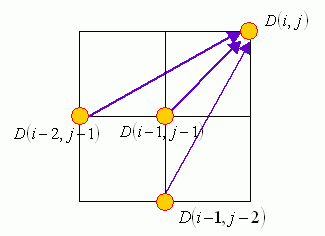
此種 local path constraint,會有下列特色:
- 會「跳點」,因此若有一點雜訊,最佳的 DTW 路徑將會跳掉此點。
- 如果最佳路徑是對應於總距離的最小值,那麼最佳路徑會盡量走 27 或 63 度,以使對應到的點數降低。
如果我們要求是「頭對頭、尾對尾」的比對,那麼由上述的 local path constraint,我們就可以推斷出 global path constraint,如下所示:
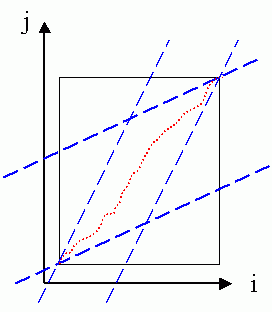
換句話說,若要使 DTW 的比對有意義,那麼兩者長度的比值必須介於 0.5 和 2.0 之間,否則我們就不可能找出一條合法的路徑。如果我們事先能夠定義 global path constraint,那麼在進行 DTW 計算時,就可以省掉很多不需要計算的部分。
如果我們要求的是「頭對頭、尾自由」的比對,例如用在「哼唱選歌」的「從頭比對」時,那麼對應的 global path constraint 如下:
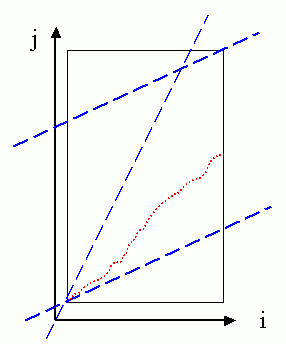
這時候可以省略的計算,就會變少。
如果我們要求的是「頭尾都自由」的比對時,對應的 global path constraint 如下:
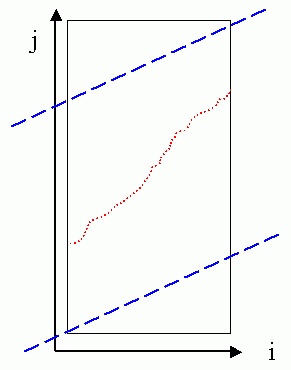
很明顯的,可以省略的計算,就更少了。
It should be noted that the global path constraints are induced as a result of the local path constraints of 27°-45°-63°. However, when we are using the local path constraints of 0°-45°-90°,sometimes we still apply the global path constraints in order to limit the mapping path to a reasonable shape. In summary, the use of global path constraints serves two purposes:
- Reduce computation load.
- Limit the mapping path to be a reasonable one.
In the following, we shall give some examples of DTW. For simplicity, we shall distinguish two types of DTW:
- Type-1 DTW uses 27°-45°-63° local path constraint.
- Type-2 DTW uses 0°-45°-90° local path constraint.
First, we can use dtw.m (with dtwOpt.type=1) and dtwPathPlot.m to plot the mapping path of type-1 DTW in the following example:
In the above example, we deliberately put an outliner in vec1. Due to the local path constraints of type-1 DTW, this outliner is skipped in the optimum mapping path.
Similarly, we can use dtw.m (with dtwOpt.type=2) and dtwPathPlot.m to plot the mapping path of type-2 DTW:
The outliner cannot be skipped since the local path constraints require each point in a vector has at least one correspondence in the other vector.
By using dtwBridgePlot.m, we can use red lines to connect corresponding points in two vectors, as follows:
It becomes more obvious that type-1 DTW can have empty correspondence while type-2 DTW can have multiple correspondences. Moreover, we can use an extra argument for dtwBridgePlot.m to put the two vectors in 3D space to have a more interesting representation:
Data Clustering and Pattern Recognition (資料分群與樣式辨認)
